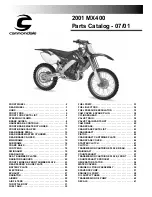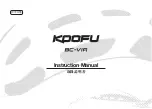
c) Steering the motorcycle (figs. C and D)
At first you must operate the gas/brake lever on the transmitter for driving functions (fig. C, pos. 4)
very cautiously and not drive too quickly, until you have learned the way the motorcycle reacts. For
this, put the control for the preset of maximum speed (fig. C, pos. 3) roughly in the middle.
To start, hold the model upright and place it on the ground (fig. D, pos. 1). At the same time as you pull
backwards to the handle on the gas/brake lever on the transmitter (fig. C, pos. 4) let the motorcycle
go. The motorcycle starts to drive.
With some practice you can use an alternative start method by leaning the motorcycle on the side
support (fig. D, pos.2). Activate the handlebar on the opposite side. If the motorcycle is, for instance,
on the left support, then use the transmitter to steer to the right. Now activate the gas/brake lever.
After a few circles the motorcycle will be upright and drive off. This starting method only works on a
smooth, non-slip surface.
To change directions, use the transmitter’s handlebar (fig. C, pos. 5) to steer in the direction the
motorcycle should go. Here you can determine the radius of the curve both by the intensity of the
handlebar movement as well as by regulation of the gas/brake lever (fig. C, pos. 4).
If the motorcycle does not have contact to the ground and you move the transmitter’s hand-
lebars, then the front wheel either does not move at all or moves in the opposite direction
of the transmitter move-ment. This is normal. Place the motorcycle on the ground and start
to drive and then the motorcycle will steer to the left or right according to the movement of
the transmitter’s handlebars.
d) Ending the run
To end the run, proceed as follows:
Let go of the gas/brake lever on the transmitter, so that it comes to rest in the neutral position and let
the motorcycle roll to a stop. Once the motorcycle has stopped, turn off the motorcycle using the on/
off switch on the motorcycle. Only then turn off the transmitter.
Attention!
End driving operation when the maximum driving speed has clearly been reduced. This
prevents an exhaustive discharge of the driving battery.
Cleaning and Maintenance
Before cleaning or maintenance, turn off the motorcycle.
After driving, clean the whole motorcycle from dust and dirt. Use, for example, a long-haired, clean
brush and a vacuum cleaner. Pressurized air sprays can also help.
Do not use cleaning sprays or household cleaners. They can damage the electronics, and such
liquids can lead to colour changes in the plastic parts or the chassis. Never wash the motorcycle with
water, for instance with a high-pressure spray. This can destroy the motor, cruise control and also the
receiver. The motorcycle (and also the transmitter) may not get damp or wet!
Use a soft cloth to wipe down the motorcycle or transmitter. Do not rub too hard as this can cause
scratches.
Motor vibrations and shocks while driving can loosen parts and screw connections on the motorcy
-
cle.
Before each use, check the model for damage. If you discover damage, do not use the motorcycle
or start it up.
Declaration of conformity (DOC)
The manufacturer hereby declares that this product is in conformity with the basic demands and other
relevant regulations pertinent to guideline 1995/5/EG.
The declaration of conformity for this product is to be found at www.conrad.com.
Disposal
a) In general
This product does not belong in household garbage.
Dispose of this product at the end of its service life according to the valid legal regulati-
ons.
Remove any batteries you may have put in the transmitter and dispose of these separately
from the product.
b) Batteries and rechargeable batteries
You as the end-consumer are legally required to return all used batteries and rechargeable batteries
(battery regulations); do not dispose with the household garbage!
Batteries and rechargeable batteries containing pollutants are labelled with the following
symbols as an indication that they may not be disposed of with household garbage. The
labels for deci-sive heavy metals are: Cd = cadmium, Hg = mercury, Pb = lead (these
designations are on the battery/rechargeable battery, for example below the garbage-can
symbol on the left.)
You may return your used batteries/rechargeable batteries without cost at the collection points in your
community, in our stores, or in any location where batteries/rechargeable batteries are sold.
When you correctly dispose of batteries you fulfil the legal regulations and also contribute to envi
-
ronmental protection.
Troubleshooting
Even though the model is made with the most up-to-date technology, there can still be problems or
defects. For this reason we would like to show you how to deal with potential problems.
The model does not respond
• Is the motor cycle’s driving battery or the battery in the transmitter empty?
• Did you turn on the transmitter and then the motorcycle? The right way: first the transmitter and then
the motorcycle!
• Is the rotary control for the preset of the motorcycle’s maximum speed turned all the way to the left?
The best position is in the middle or to the right.
• Is the motorcycle too far away? When the driving battery and the transmitter battery are full, a
range of roughly 20 m is possible. This can, however, be limited by ambient influences, or instance
another transmitter at the same or near frequency (for instance WiFi equipment, Bluetooth, etc.)
The motorcycle slows down or stops, limited or no reaction to steering commands.
• The driving battery in the motorcycle is weak or empty.
• The motorcycle’s under voltage recognition system is activated (driving battery empty); the LED on
the front light is out. Turn off the motorcycle and charge the battery.
The range between transmitter and motorcycle is very short.
• Check the transmitter batteries.
• Check whether other equipment with a 2.4 GHz radio area are near to the transmitter or motorcycle
and turn these off.
Technical data
a) Motorcycle
Driving battery ..........................................
1cell LiPo battery (permanently installed, not replaceable)
Driving time ...............................................
ca. 10 minutes
Charging time ...........................................ca. 45 minutes
Dimensions (L x B x H)
.............................
140 x 78 x 90 mm
Weight ......................................................
ca. 110 g
b) Transmitter
Operating current
......................................
6 V/DC (4 batteries type AA/Mignon)
Transmission frequency............................
2.4 GHz
Range
.......................................................ca. 20 meters
Dimensions (H x B x T) .............................
160 x 130 x 70 mm
Weight ......................................................ca. 225 g (incl. batteries)
This is a publication by Conrad Electronic SE, Klaus-Conrad-Str. 1, D-92240 Hirschau (www.conrad.com).
All rights including translation reserved. Reproduction by any method, e.g. photocopy, microfilming, or the capture in
electronic data processing systems require the prior written approval by the editor. Reprinting, also in part, is prohibited.
This publication represent the technical status at the time of printing.
© Copyright 2015 by Conrad Electronic SE.



























